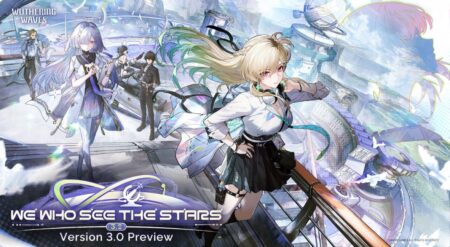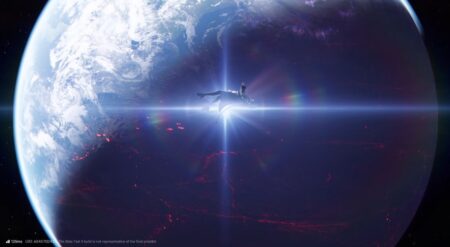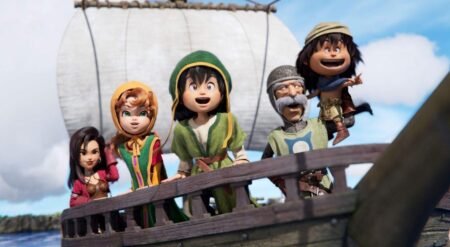Giant Squid, the indie studio behind ABZÛ and The Pathless, is gearing up to release Sword of the Sea. The latest addition to their credits, Sword of the Sea is a new atmospheric surfing adventure that continues the studio’s tradition of unique artistic design, captivating scores (this one from composer Austin Wintory), but more importantly, puzzles. During Summer Game Fest Play Days, we went hands-on with the title, with Creative Director Matt Nava there to guide us.
In Sword of the Sea, players embody the Wraith, resurrected in the desolate Necropolis. Your quest is to unveil the ancient sea buried beneath the land, exploring sinking tombs and skatepark-inspired ruins that hold the remnants of a lost culture.
As you surf the dunes of a desolate land, pieces of the past stick out, asking you to search them, and ultimately, release the water trapped away. While the complete game will push the Wraith to search for their purpose, the Play Days demo had little context for the story.
Instead, Giant Squid lets players, the media, and content creators in attendance skate through the sand (or surf) and find their way through environmental puzzles. In some, you build momentum in a halfpipe and pull off inventive platforming to find the release point for the water. In others, you grind giant chains linking pillars. And another will have you scale giant seaweed to move onto the next area.
Traversal mechanics, puzzles, and music, Giant Squid nails it all in Sword of the Sea.

Sword of the Sea’s greatest success is its intuitive level design and thoughtful control schemes that iterate on classic THPS controls. This combo makes the game easy to swim through but challenging to complete. In my time with the game, I never got frustrated. Instead, I got curious.
As you progress, sandy dunes transform into glittering, emerald waters, and magical sea life returns in breathtaking shoals. This brings a spiritual magic to surfing as you connect with nature and restore life. However, a lurking darkness under the waves hints at challenges beyond the serene exploration.
The use of an organic environment, softly shifting sand, and sharp color palette differences between cool and warm turn Sword of the Sea into something ethereal. I had fully intended to talk to Matt Nava while I was playing, but instead, I put on the headset and played.
Nava’s only real instruction came when he pointed out that I could scale the seaweed to move on. Other than that, the music and movement were like a warm hug. I was lulled into it, but never grew tired. Instead, I was relaxed and engaged in a way I hadn’t felt in quite some time.
Sword of the Sea is a unique achievement that feels familiar but novel at the same time.

The relaxation didn’t come from Sword of the Sea’s simplicity. The high-speed Hoversword movement can be fast and loose when just surfing the dunes. But if you need to platform, you have to be precise. The shifting tones between precision and speedy fun are balanced extremely well.
Giant Squid has drawn inspiration from the fluid motions of skateboarding and snowboarding, right down to the control scheme and halfpipe. As you move through the world, you carve your way across the environment on an ancient and powerful weapon. You rely on it, the land, and pulling your body into build momentum and launch yourself across gaps, over dunes, and ultimately find a way through vertical environmental puzzles to complete your quest.
The limited UI helps with immersion, but it’s how fluid the movement between flips and grabs is, or how beautifully you glide. It is not too easy, not too hard. Sword of the Sea puts you into a flow state that you don’t want to leave. The game’s ability to oscillate between weighty action as you grind walls and chains into something more meditative as you coast on open sand or sea is special.
Limited UI helps immerse the player in the whimsy and depth of the world.

From a visual standpoint, Giant Squid pulls off creating an environment that is continuously moving. The sand moves, the water moves, and it’s all alive. Or at least it feels like it. Sword of the Sea’s world looks like how my abuela would talk about the land. Something that you’re connected to, moving with, living because of, and ultimately something worth protecting and showing reverence. It’s hard to detach that Native concept from time with the game, and that made it all the more special.
Games like this that try to show the land constantly shifting, whether with subtle ripples or large undulations, tend to trigger my motion sickness. But for some reason, I didn’t get sick. Despite having my motion sickness trip twice during Play Days, this game didn’t do that, which is a testament to its design and development of horizon views in relation to the ground.
Sword of the Sea is another thoughtfully crafted experience from Giant Squid. The game combines a unique traversal mechanic, gorgeous worldbuilding, diverse environmental design, and ultimately, it trusts players to find their way. While demo time didn’t give me a view into the whole game, it did create one of the best experiences I had during Play Days.
Giant Squid’s Sword of the Sea Is Thrilling And Meditative | Hands-On Preview
Sword of the Sea is another thoughtfully crafted experience from Giant Squid. The game combines a unique traversal mechanic, gorgeous worldbuilding, diverse environmental design, and ultimately, it trusts players to find their way. Sword of the Sea is launching on August 19, 2025, for PlayStation 5 and PC (via Steam and the Epic Games Store).







